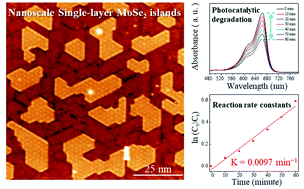Controllable fabrication and photocatalytic performance of nanoscale single-layer MoSe2 islands with substantial edges on an Ag(111) substrate†
Abstract
Two-dimensional (2D) transition metal dichalcogenides (TMDs) are emerging as new electrocatalysts and photocatalysts. The edge sites of 2D TMDs show high catalytic activity and are thus favored at the catalyst surface over TMD inert basal planes. However, 2D TMDs that predominantly expose edges are thermodynamically unfavorable, limiting the number of edge sites at the surface. Herein, we demonstrate a controllable synthesis strategy of single-layer 2D MoSe2 islands with a lateral size of approximately 5–12 nm on an Ag(111) substrate by pre-deposition of excess Se atoms. The surplus Se atoms react with the Ag(111) substrate and form silver selenide compounds to separate MoSe2 islands and further prevent MoSe2 islands from growing up. The nanoscale MoSe2 islands greatly increase the ratio of exposed edge sites relative to the basal plane sites, which leads to excellent photocatalytic activity for the degradation of a methylene blue (MB) organic pollutant. This work paves the way to limit the size of 2D TMDs at the nanoscale and enables new opportunities for enhancing the catalytic activity of 2D TMD materials.



 Please wait while we load your content...
Please wait while we load your content...